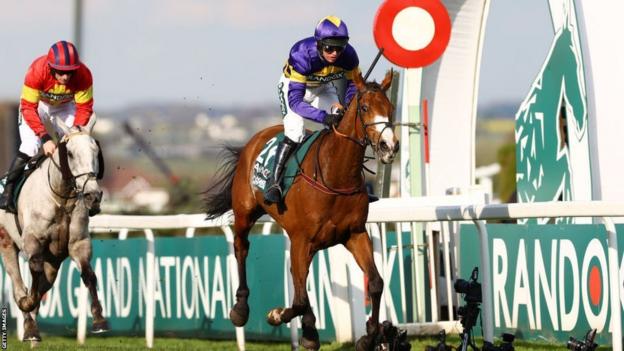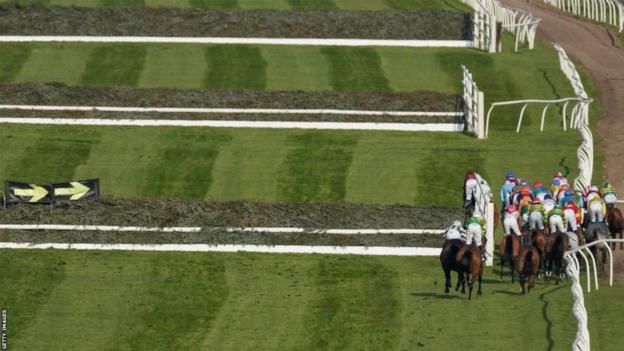
The Grand National will be reduced to a maximum of 34 runners from 40 as part of measures designed to improve safety.
One horse died in this year’s race, which was delayed by 14 minutes after a protest by animal rights activists.
Organisers plan an earlier race time at Aintree to provide safer ground for runners, and a shorter run to the first fence to slow horses down early on.
The introduction of a standing start and further veterinary checks are among other changes.
There had been some calls for the line-up to be reduced to 30 runners, but Aintree clerk of the course Sulekha Varma said that could be counter-productive.
“We know from research papers and internal analysis of jump races that there is a direct correlation between the number of runners and the risk of falling, unseating or being brought down,” she said.
“However, we also must consider that reducing the field size by too great a number could create a faster race and have an adverse impact in terms of safety.”
There were three equine fatalities across the three-day National meeting in April, with protesters from Animal Rising attempting to halt the big race itself, although racing chiefs say the changes were not prompted by the protests.
Merseyside Police said 118 people were arrested over the disruption and its investigation is ongoing although no-one has yet been charged six months on.
Emma Slawinski, director of policy at the RSPCA, welcomed the new steps at Aintree, but said more could be done.
“We look forward to seeing this announcement pave the way for further changes,” she added.
Nevin Truesdale, chief executive of Aintree owners the Jockey Club, said the changes were part of the organisation’s “relentless focus on welfare”.
- Grand National 2023: What happened and the fallout from it
- Trainer blames delays caused by protesters for horse death

What are the changes?
The Grand National, regarded by many as the world’s most famous horse race, features jockeys and horses negotiating 30 fences over more than four miles, and is watched by an estimated 600 million people worldwide.
There have been five fatalities from 395 runners in the 10 Grand Nationals raced since widespread changes were introduced in 2012 following a safety review.
A review takes place after each running and this year the Jockey Club, together with the British Horseracing Authority, said it “recognised the need for more substantial updates on several key areas in order to better protect the welfare of racehorses and jockeys”.
The changes, to take effect from the next Grand National on 13 April 2024, are:
- Cutting the maximum number of runners from 40, a limit introduced in 1984, to 34.
- Moving the first fence 60 yards closer to the start, and implementing a standing start – rather than letting horses run in – to all races over the National fences. Research showed speeds to the first fence had increased to about 35mph from 28mph in recent years.
- Bringing forward the start time from 17:15 BST as the ground conditions can become quicker as it dries out on a breezy, sunny April afternoon. It is thought the revised time is likely to be between 15:45 and 16:15.
- Horses will no longer be led by a handler on course during the pre-race parade before the grandstands, so they can prepare in their own time.
- Changes to the alignment of the running rail on the inside of the course to help catch loose horses.
- Reducing height of 11th fence by two inches, from 5ft to 4ft 10in, on take-off side and some ‘levelling off’ on landing side to reduce height of the drop. The fence was shown to have an unusually high number of fallers, horses being brought down and unseated riders in all races over the National course.
- Introducing softer foam and rubber ‘toe boards’ at the foot of the jumping side of every fence.
- More pop-up irrigation to water the course; and widening paddock walkways.
- Raising the minimum handicap rating for horses to 130 from 125, which brings it in line with top-level Grade One races.
- A review panel of industry experts who assess the suitability of every runner to take a closer look at horses that have made jumping errors in 50% or more of their last eight races before allowing them to take part.

While animal rights activists may argue the changes do not go far enough, some racing supporters will see it as a further dilution of the contest’s unique characteristics.
If the field had been down to 34 previously, two recent winners – Auroras Encore (2013) and Minella Times, who made history in 2021 when Rachael Blackmore became the first female jockey to triumph – would not have made the cut.
“There are lots of people who don’t like change but all sports change,” two-time National-winning jockey Ruby Walsh said.
“Soccer is not the same game it was 30 or even 15 years ago and looking at the Rugby World Cup, rugby has had to evolve. Racing is the same in that we have to evolve to ensure the future of the sport.”
The race’s start time was put back an hour in 2016 in an attempt to attract a wider audience.








